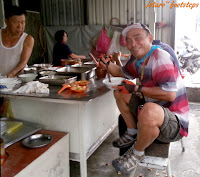You are at - Jotaro's Blog / Footsteps / Thailand 2016-Sites / Jui Tui Shrine Phuket (Jui Tui Tao Boh Kaeng)
Footsteps - Jotaro's Travels
THE ENTRANCE
A look at the elaborately designed entrance tower. Entrance towers are seldom seen in Chinese temples. This is actually a fire-cracker house used to light fire-crackers in during celebrations.
THE MAIN TEMPLE PAVILION
 |
| The hall has red column headers that looks similar to those of Japanese temples. |
Colourful flags precede the entrance to the main temple hall.
The two roofs of the main hall has ridges that curl skywards and end with a sharp jagged edge. It's simplistic yet elegant.
The entrance roof to the main hall - the ridge wall is made more intricate by green bamboo mini columns.
The entrance foyer to the main hall, a dragon joss-burner urn sits right in front.
The entrance foyer roof.
Joss-burner at the entrance foyer. The fierce dragons will scare off any evil spirits.
Horizontal banners hang form the ceiling of the entrance; these are uniquely white in colour with colourful motifs dragons, deities, etc. embroided on.
The main prayer hall has three altars; a main one at the centre and two secondary ones on the sides. Jui Tui Shrine is dedicated to Tean Hu Huan Soy, the god associated with performing artists and dancers (The Chinese Opera regards him as their patron). His statue take up the central position of the main altar.
Behind the main altar table is an altar for other important deities and standing slightly elevated is Kuan Im.
A closer look of Kuan Im, this one has her carrying a child. Childless couple would come prayer to her and hope for a child soon.
ANCILLARY BUILDINGS
Within the compound there are a couple of ancillary smaller buildings, one is a shrine and the other a hell-notes burner.
The burner building has unique weave/lattice patterns on it's walls, the design is graphical one that is seldom seen in Chinese temples. Another uniqueness are the "lion" heads that adorn the gable ends of the roof.
A closer look of the roof.
A couple of green dragons adorn the gable wall of another building.
STATUES
Many statues are placed within the temple, shown here are statues within the compound:
Two stone lion guardians guard the entrance to the main temple hall.
A close look at one of the stone lion guardians.
A rich royal blue porcelain lion, this is a small one that sits at the entrance of the small shrine at the right of the main temple.
The following are the four deities that stand vigilantly guarding the entrance to the main prayer hall (There are two other guards at the entrance arch, but against the morning sunlight, my photos of them did not come out well):
JUI TUI SHRINE
Soi Phuthorn, Ranong Road, Phuket Old Town, Phuket, Thailand.
Hours: 8:00am to 8:30pm
GPS: 7.88324, 98.38338
(Click here for Google Street View)
Related / Similar Blogs :
You may also like :
You are at - Jotaro's Blog / Footsteps / Thailand 2016-Sites / Jui Tui Shrine Phuket (Jui Tui Tao Boh Kaeng)
If you like this, view my other blogs at Jotaro's Blog
(comments most welcomed below. if you like this pls share via Facebook or Twitter)
(comments most welcomed below. if you like this pls share via Facebook or Twitter)



















































Thanks a lot very much for the high your blog post quality and results-oriented help. I won’t think twice to endorse to anybody who wants and needs support about Web Developer Phuket.
ReplyDelete